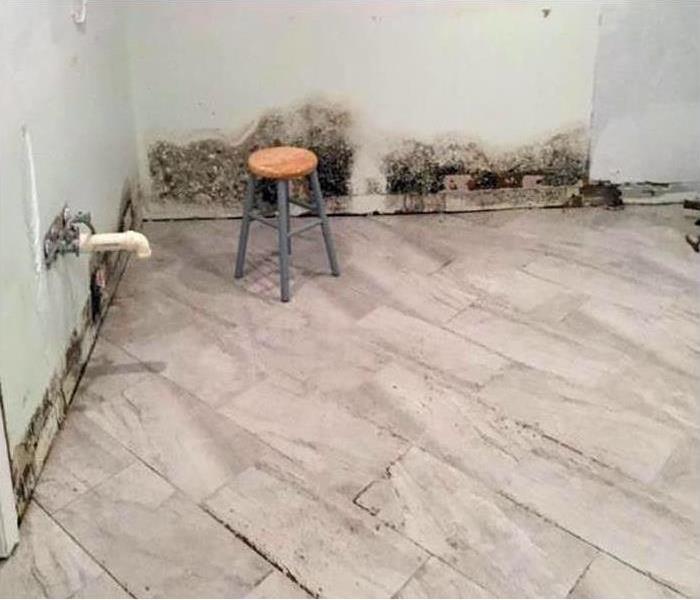Safeguarding Against New Haven Residential Mold
11/3/2022 (Permalink)
Understanding Mold Damage Prevention Strategies
Preventing mold can be an essential focus for homeowners, especially when you consider that your insurance does not often cover the destruction of your home. Protecting your home starts with understanding how to avoid microbial and fungal growth.
Mold Can Impact Many Areas of a House
Mold is a nuisance in and outside of your home and, as a living organism, continues to spread under favorable conditions in your house. Damp environments provide the needed requirements for facilitating mold growth.
The CDC suggests mold is everywhere, and in the outdoors, it rarely concerns property owners. These organisms are often found in the soil or moist, shaded spaces. However, mold damage can also infiltrate New Haven homes in areas like the basement, bathrooms, kitchens, and inside of wall systems where plumbing leaks or other water damage might encourage growth.
While many molds that can form and spread in your home are not toxic to the property owners, those with allergies could experience difficulties after exposure. The primary threat of mold growth is the impact on building materials, interior structural systems, and the contents of the property.
Does Your Insurance Cover Mold?
Not surprisingly, your home insurance provider does not cover everything that happens in your home. An insurance provider protecting your home will consider these maintenance issues like rot or insect infestations. The exception for many homeowners is mold caused by conditions your policy typically covers, like burst pipes and leaks.
Some properties might be protected through flood insurance for secondary damages attributed to this natural disaster, such as mold or mildew development.
It is unlikely that your property gets protected against mold damage, and if it does, there is generally a small payout limit–typically up to $5000. Despite SERVPRO being a leader in the region's mold remediation and cleanup services, we want to encourage homeowners to pursue active preventative measures to keep their properties safe from destructive microbial colonization.
What Can You Do to Avoid Mold in Your Home?
Steps are possible to avoid the need for remediation by our SERVPRO team or mold damage reconstruction by our trusted partners with Connecticut Reconstruction Services (CRS.) Here are some dos and don'ts for safeguarding your property:
- Do: Install exhaust fans for bathrooms and kitchens to reduce moisture and steam.
- Do: Utilize equipment like dehumidifiers or air conditioners to maintain humidity levels of 30-60%
- Do: Use mold inhibitors with the primer when painting walls and ceilings in your house.
- Do: Inspect your roof regularly for damage that could result in water seepage or penetration to the attic.
- Do: Inspect hoses and fittings for leaks that could cause widespread moisture damage to appliances in your home.
- Do: replace hoses and connectors as wear becomes apparent, and you should check all water-fed appliances like certain refrigerators, water heaters, sinks, toilets, dishwashers, and washing machines.
- Do: Clean bathrooms, kitchens, and laundry rooms with sporicidal products like bleach.
- Don't: Allow water to accumulate and sit underneath houseplants.
- Don't: Install carpeting in known damp areas of your home.
- Don't: Allow gutters to collect leaves and debris, which could lead to water damage – clean them at regular intervals.
Steps to Address Mold After Flooding or Water Damage
Signs can indicate mold growth in your house, such as a musty smell or discoloration of wall systems, possibly hosting an active colony. Signs can appear in as little as 48 hours after water damages, and a fast call to SERVPRO ensures that your New Haven home receives prompt mitigation and remediation, such as:
- Extraction – Removing standing water reduces the wetness needed to facilitate mold growth, and the longer this pooling persists, the more microorganisms SERVPRO professionals must overcome.
- Removing Saturated Fabrics – Carpets, padding, clothing, upholstery, and other fabrics throughout a flooded or water-damaged home must be discarded and replaced if they cannot be dried before mold develops.
- Removing Early Mold – Chlorine-based cleaning products and sporicidal solutions disinfect non-porous surfaces, remove early mold development on surfaces, and act as an inhibitor for further microbial growth.
- Disposing Mold-Damaged Rubbish – Organic matter like rags, debris, and paper can amplify spore activity if not removed from the affected areas.
- Resolve the Moisture – Preventing further mold damage relies on SERVPRO and trusted partners to repair and restore water penetration points.
If you are dealing with mold damage in your home, trust our fast remediation response. You can reach our SERVPRO of New Haven experts 24/7 at (203) 234-1100.






 24/7 Emergency Service
24/7 Emergency Service